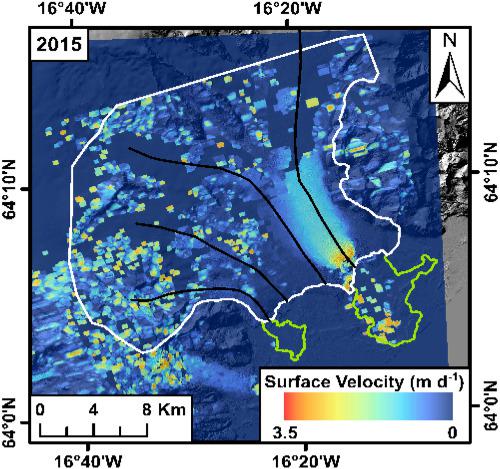当前位置:
X-MOL 学术
›
Earth Surf.Process. Land.
›
论文详情
Our official English website, www.x-mol.net, welcomes your feedback! (Note: you will need to create a separate account there.)
Long‐term impact of the proglacial lake Jökulsárlón on the flow velocity and stability of Breiðamerkurjökull glacier, Iceland
Earth Surface Processes and Landforms ( IF 3.3 ) Pub Date : 2020-07-04 , DOI: 10.1002/esp.4920 Nathaniel R. Baurley 1 , Benjamin A. Robson 2 , Jane K. Hart 1
Earth Surface Processes and Landforms ( IF 3.3 ) Pub Date : 2020-07-04 , DOI: 10.1002/esp.4920 Nathaniel R. Baurley 1 , Benjamin A. Robson 2 , Jane K. Hart 1
Affiliation

|
Proglacial lakes are becoming ubiquitous at the termini of many glaciers worldwide due to continued climate warming and glacier retreat, and such lakes have important consequences for the dynamics and future stability of these glaciers. In light of this, we quantified decadal changes in glacier velocity since 1991 using satellite remote sensing for Breiðamerkurjökull, a large lake‐terminating glacier in Iceland. We investigated its frontal retreat, lake area change and ice surface elevation change, combined with bed topography data, to understand its recent rapid retreat and future stability. We observed highly spatially variable velocity change from 1991 to 2015, with a substantial increase in peak velocity observed at the terminus of the lake‐terminating eastern arm from ~1.00 ± 0.36 m day−1 in 1991 to 3.50 ± 0.25 m day−1 in 2015, with mean velocities remaining elevated from 2008 onwards. This is in stark comparison to the predominately land‐terminating arms, which saw no discernible change in their velocity over the same period. We also observed a substantial increase in the area of the main proglacial lake (Jökulsárlón) since 1982 of ~20 km2, equating to an annual growth rate of 0.55 km2 year−1. Over the same period, the eastern arm retreated by ~3.50 km, which is significantly greater than the other arms. Such discrepancies between the different arms are due to the growth and, importantly, depth increase of Jökulsárlón, as the eastern arm has retreated into its ~300 m‐deep reverse‐sloping subglacial trough. We suggest that this growth in lake area, forced initially by rising air temperatures, combined with the increase in lake depth, triggered an increase in flow acceleration, leading to further rapid retreat and the initiation of a positive feedback mechanism. These findings may have important implications for how increased melt and calving forced by climate change will affect the future stability of large soft‐bedded, reverse‐sloped, subaqueous‐terminating glaciers elsewhere. © 2020 The Authors. Earth Surface Processes and Landforms published by John Wiley & Sons Ltd
中文翻译:

冰河湖Jökulsárlón对冰岛Breiðamerkurjökull冰川的流速和稳定性的长期影响
由于持续的气候变暖和冰川退缩,全球许多冰川的终点处无处不在的冰川湖,这种湖泊对这些冰川的动力和未来的稳定性具有重要的影响。有鉴于此,我们利用1991年以来冰岛大湖终止冰川Breiðamerkurjökull的卫星遥感对冰川速度的年代际变化进行了量化。我们结合其床前地形数据研究了其正面撤退,湖泊面积变化和冰面高程变化,以了解其最近的快速撤退和未来的稳定性。从1991年到2015年,我们观察到了高度空间变化的速度变化,在以湖为终点的东臂末端观测到的峰值速度从1.00±0.36 m天-1显着增加。从1991年的3.50±0.25 m天-1到2015年,平均速度从2008年开始保持上升。这与主要是陆地终结的手臂形成了鲜明的对比,后者在同一时期内没有看到明显的速度变化。自1982年以来,我们还观察到主冰川湖(Jökulsárlón)的面积显着增加了〜20 km 2,相当于0.55 km 2 年的年增长率-1。在同一时期,东部分支撤退了约3.50 km,远大于其他分支。不同分支之间的这种差异是由于Jökulsárlón的增长,以及重要的是深度的增加所致,因为东部分支已经退缩到了约300 m深的反向倾斜的冰川下槽中。我们认为,最初由于气温上升而导致的湖泊面积增长,再加上湖泊深度的增加,触发了水流加速度的增加,从而导致了进一步的快速退缩并建立了积极的反馈机制。这些发现可能对气候变化导致的融化和裂隙增加将如何影响其他地方的大型软床,反向倾斜,水底终止冰川的未来稳定性具有重要意义。©2020作者。
更新日期:2020-07-04
中文翻译:

冰河湖Jökulsárlón对冰岛Breiðamerkurjökull冰川的流速和稳定性的长期影响
由于持续的气候变暖和冰川退缩,全球许多冰川的终点处无处不在的冰川湖,这种湖泊对这些冰川的动力和未来的稳定性具有重要的影响。有鉴于此,我们利用1991年以来冰岛大湖终止冰川Breiðamerkurjökull的卫星遥感对冰川速度的年代际变化进行了量化。我们结合其床前地形数据研究了其正面撤退,湖泊面积变化和冰面高程变化,以了解其最近的快速撤退和未来的稳定性。从1991年到2015年,我们观察到了高度空间变化的速度变化,在以湖为终点的东臂末端观测到的峰值速度从1.00±0.36 m天-1显着增加。从1991年的3.50±0.25 m天-1到2015年,平均速度从2008年开始保持上升。这与主要是陆地终结的手臂形成了鲜明的对比,后者在同一时期内没有看到明显的速度变化。自1982年以来,我们还观察到主冰川湖(Jökulsárlón)的面积显着增加了〜20 km 2,相当于0.55 km 2 年的年增长率-1。在同一时期,东部分支撤退了约3.50 km,远大于其他分支。不同分支之间的这种差异是由于Jökulsárlón的增长,以及重要的是深度的增加所致,因为东部分支已经退缩到了约300 m深的反向倾斜的冰川下槽中。我们认为,最初由于气温上升而导致的湖泊面积增长,再加上湖泊深度的增加,触发了水流加速度的增加,从而导致了进一步的快速退缩并建立了积极的反馈机制。这些发现可能对气候变化导致的融化和裂隙增加将如何影响其他地方的大型软床,反向倾斜,水底终止冰川的未来稳定性具有重要意义。©2020作者。



























 京公网安备 11010802027423号
京公网安备 11010802027423号